FeelReal: The social media app where reality is more important than fakeness
Nowadays, you can’t make a friend without having them connected to you on Whatsapp, Facebook, or Instagram. The social media hype is only understandable given the fact that your connection with these new friends is taken to another social level, plus the added bonus of following your favourite public figure; keeping up with Kim Kardashian’s selfies can be one way to enjoy it! However, the standards set by many popular social media users have influenced all other users (especially youths) both positively and negatively; it has a power over self-esteem and idea of body image as it continuously forces users compare their lives to the glamour and beauty that is social media fame.
The power of media
According to Foucault (1982), power is ‘an everyday, socialized phenomenon’ (Bonanno 2014, 1). He believes that the subject is produced by the structures around it (Foucault 1982, 777). Furthermore, Derrida elaborates on the idea of media agencies and ‘teletechnologies’ controlling the subject’s ‘performance’ (Derrida, Stiegler and Bajorek 2002, 42 & 122). In this case, the subject are the users of social media platforms and the platforms are the structures that mould them.
According to Kincheloe, Weed and Lack (2010), social media is designed to ‘increase ease of information sharing online and help keep persons connected in ways previously impossible’ (Kincheloe et al. 2010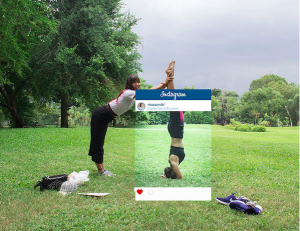 , 80). However, when we look at different social media platforms where users are asked ‘What’s on your mind’ (Facebook) and ‘What’s happening’ (Twitter), the original purpose of social media seems to be overlooked. This is partly due to social media platforms taking advantage of user’s profile data to create personalised advertisements. Also, social media platforms allows users to adjust reality by editing posts and adding filters. As a result, what users post on social media is no longer authentic. We believe that social media should return to its original purpose. Not just because of principle, but to shield users, and especially young users, from being influenced by a fake the reality projected online.
, 80). However, when we look at different social media platforms where users are asked ‘What’s on your mind’ (Facebook) and ‘What’s happening’ (Twitter), the original purpose of social media seems to be overlooked. This is partly due to social media platforms taking advantage of user’s profile data to create personalised advertisements. Also, social media platforms allows users to adjust reality by editing posts and adding filters. As a result, what users post on social media is no longer authentic. We believe that social media should return to its original purpose. Not just because of principle, but to shield users, and especially young users, from being influenced by a fake the reality projected online.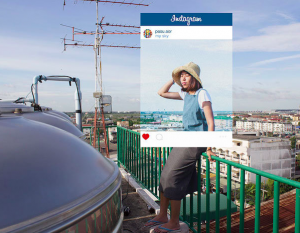
Nevertheless, it is the perfect tool for keeping up with family, friends and the world. The aim of this project is to create a social media platform which is free from performativity and shows reality. We want to come up with a solution to try and shield users from the effects of social media instead of advising them to quit it, which wouldn’t be suitable for a modern society. Users should show their friends what’s going on while keeping it real. Thus, no filters, no advertisement and no “fauxthenticity” (fake authenticity).
Social media effects
More research is being done on the effects it has on its users; however, studies have come to different conclusions. Firstly, research has shown that Facebook use has a positive effect on users since it can lead to the ego-fulfilment needs (Toma and Hancock 2013), greater subjective well-being (Kim and Lee 2011) and higher relationship quality for those in a romantic relationship (Steers, Overup, Brunson and Acitelli 2014).
Negatively, however, there is a connection between the amount of time spent on social media and psychological behaviour (Moreno et al. 2011; Morrison & Gore 2010; Steers, Wickham and Acitelli 2014). A reason for this effect has to do with the way users perceive other users online. People who posses a Facebook account over a longer period of time or who spent more hours per week on Facebook believe that other users have better lives than they have (Chou and Edge 2012; Jordan et al. 2011). People who perceive themselves as ‘lower’ compared to others have more negative health outcomes such as depressive symptoms, lower self-esteem and negative self-evaluations (Allan and Gilbert 1995).
Moreover, studies have shown that there is a connection between the age of users on social media and the effect social media has on their social behaviour (Steers et al. 2014). Since young adults become self-aware and compare themselves to others, social media affects kids’ emotional development by forming their behaviour and the way they perceive themselves (McGrath 2015; Steers et al. 2014).
FealReal
Since the aim of this project is to shield users from the negative effects of social media – to distinguish ‘fake’ from ‘real’ – we have invested the social media platform which shows reality: “FeelReal” (FR). FR will distinguish itself from general social media platform. First of all, the platform is a private space, free from advertisement, where close friends can be comfortable to share their reality. FR-users get pop-ups everyday at a random moment when their mobile phones are active. The user can choose how many times a day the popup will appear but cannot choose the moment. When the mobile phone is in use, it forces the user to take a picture in that precise moment in time. The user gets 30 seconds, if the picture is not taken, an image with “FauxDay” will appear on his timeline. Other users can add friends to follow them and review the pictures. Finally, this will result in a timeline with what is really happening (or not happening).
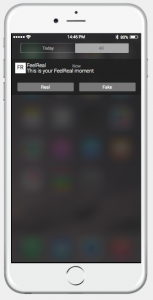
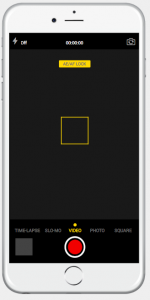
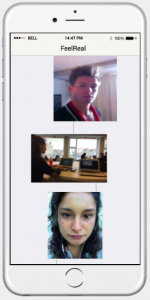
A preview of the interface of the FeelReal app
To ensure the realness of FR it will not be possible to make use of filters; it will make use of alternating camera-use, which means that the user one day is forced to take the picture front face (also known as ‘selfie’) and the other day back face (picture of what the user is doing at that random moment); and will it not give other opportunities, except for creating a timeline about the real. By developing FeelReal, we are aiming to stop the distorted and misleading image of the ‘fake’ and we hope to challenge people to show the ‘real’. By following people on FeelReal, one is able to check-out the realness of someone. When a FR-user has chosen to not use his mobile phone, we recommend to stop the connection. Without any connection an image will appear on the timeline with “In Real Time”.
Future expectations
Research has shown that negative body image and negative social behaviour are examples of negative social media effects. Our new application is aiming for positive impacts, where users of the platform can be a part of the social media environment and won’t have to feel excluded of this ‘social media’ world. Research also has shown that users can feel intimidated by seeing perfection, and jealous from these lifestyles (Allan and Gilbert 1995; Chou and Edge 2012; Jordan et al. 2011). Therefore our new app will gain users who are also willing to deconstruct social media’s current image of reality and therefore present a positive society. Where the lifestyle and the presence of online users are comparable with real persons (instead of a fake representation of people). This application is aiming for a promotion of a genuine reality for a better society where all negative impacts can be turned into positive impacts.
References
Allan, Steven, and Paul Gilbert. “A social comparison scale: Psychometric properties and relationship to psychopathology.” Personality and Individual Differences. 19.3 (1995): 293-299.
Bonanno, Emma R. “The Social Media Paradox: An Examination of the Illusion Versus the Reality of Social.” Sociological Imagination: Western’s Undergraduate Sociology Student Journal. 3.1 (2014): 1-13.
Chou, Hui-Tzu Grace, and Nicholas Edge. “ “They are happier and having better lives than I am”: the impact of using Facebook on perceptions of others’ lives.” Cyberpsychology, Behavior, and Social Networking. 15.2 (2012): 117-121.
Derrida, Jacques, Bernard Stiegler, and Jennifer Bajorek. Echographies of Television: Filmed Interviews. 1st ed. Cambridge: Wiley, John & Sons, 2002.
Foucault, Michel. “The Subject and Power.” Chicago Journals. 8.4 (1982): 777-795.
Jordan, Alexander H., et al. “Misery has more company than people think: Underestimating the prevalence of others’ negative emotions.” Personality and Social Psychology Bulletin. 37.1 (2011): 120-135.
Kim, Junghyun, and Jong-Eun Roselyn Lee. “The Facebook paths to happiness: Effects of the number of Facebook friends and self-presentation on subjective well-being.” CyberPsychology, behavior, and social networking. 14.6 (2011): 359-364.
Kincheloe, Matthew T., David Weed, and Calev W. Lack. “Facebook and Psychology: Use and Misuse of Social Networks.” Recent Advances in Clinical Medicine. (2010): 80-83.
McGrath, Mary. “Social media can pressure teens to seek perfect body.” AAP News 36.1 (2015): 23-23.
Moreno, Megan A., et al. “Feeling bad on Facebook: depression disclosures by college students on a social networking site.” Depression and anxiety. 28.6 (2011): 447-455.
Morrison, Catriona M., and Helen Gore. “The relationship between excessive Internet use and depression: a questionnaire-based study of 1,319 young people and adults.” Psychopathology. 43.2 (2010): 121-126.
NSMBL. Deze awesome fotoserie toont de waarheid achter alle ‘perfecte’ Instagrams. September 18, 2015. October 14, 2015. <http://www.nsmbl.nl/deze-awesome-fotoserie-toont-de-waarheid-achter-alle-perfecte-instagrams/>.
Steers, Mai-Ly N., Robert E. Wickham, and Linda K. Acitelli. “Seeing Everyone Else’s Highlight Reels: How Facebook Usage is Linked to Depressive Symptoms.” Journal of Social and Clinical Psychology. 33 (2014): 701-731.
Toma, Catalina L., and Jeffrey T. Hancock. “Self-affirmation underlies Facebook use.” Personality and Social Psychology Bulletin. 39.3 (2013): 321-331.
“What’s on your mind.” Youtube. June 2, 2014. October 14, 2015. <https://www.youtube.com/watch?v=QxVZYiJKl1Y>.